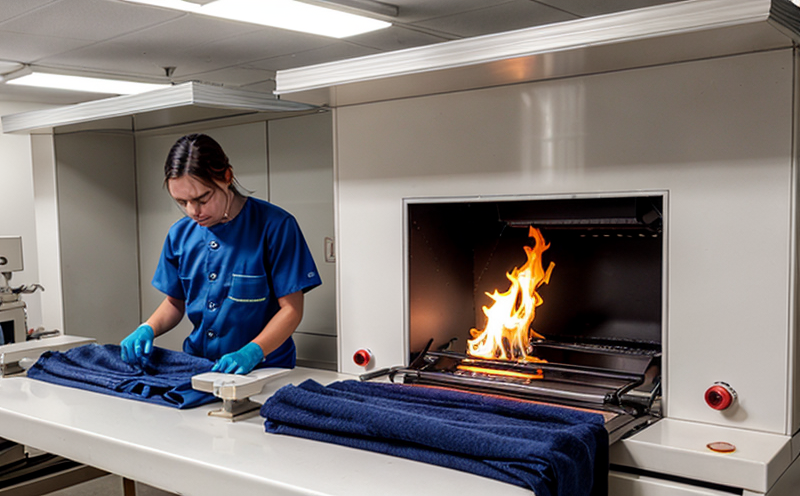Fire Resistance Testing of Protective Jackets
The fire resistance testing of protective jackets is a critical aspect of ensuring worker safety in environments where there is an elevated risk of flame exposure. This type of testing evaluates the ability of materials to resist ignition and prevent the spread of flames, thereby protecting individuals from burns or other injuries.
Protective jackets are often worn by firefighters, emergency responders, industrial workers, and others whose jobs put them at high risk for fire-related incidents. The performance of these garments in real-world scenarios can mean the difference between life and death. This testing ensures that the materials used meet rigorous standards designed to protect users effectively.
The process involves subjecting a sample of protective jackets to controlled flame exposure according to established protocols. Key factors include the duration of contact with flames, heat transfer rates, and the time it takes for the garment to self-extinguish after being removed from the source of fire. These parameters are crucial in determining how well the jacket can insulate against high temperatures and protect the wearer.
One important aspect of this testing is understanding the material composition of the protective jackets. Common materials include Nomex, Kevlar, and other advanced fibers that offer superior thermal stability compared to traditional textiles like cotton or polyester. The choice of fabric significantly influences the jacket's fire resistance properties; hence it must be carefully selected based on intended use.
Another critical factor is proper sample preparation which involves cutting precise pieces from the jacket according to specified dimensions laid out in relevant standards such as ISO 13565-2 or ASTM D6413. Proper handling and storage of samples before testing are also essential steps that can affect results if not conducted correctly.
During actual testing, there is typically a series of stages including preheating the sample, exposing it to direct flame for a set period, measuring temperature changes both on and off the jacket surface, recording how long the fabric continues burning after being removed from the heat source, etc. All these measurements are compared against benchmark values defined by governing bodies like OSHA or NFPA (National Fire Protection Association).
The outcome of such tests provides valuable insights into whether a particular protective garment meets industry expectations regarding flame resistance performance. Compliance with specific standards ensures consistent quality across all batches produced by manufacturers, which is particularly important given the high stakes involved.
For instance, in Europe, EN ISO 13565-2 specifies procedures for determining the heat resistance of fabrics used in protective clothing. Similarly, ASTM D6413 outlines similar requirements but applies more broadly to various types of flame-resistant garments beyond just jackets.
In summary, fire resistance testing plays a vital role in safeguarding workers exposed to potential hazards from flames or intense heat sources. By rigorously examining each batch of protective jackets through standardized methods, manufacturers can guarantee their products' effectiveness at protecting users against severe burns and other injuries caused by unexpected incidents.
Applied Standards
The fire resistance testing of protective jackets adheres to several international standards aimed at ensuring consistent quality and performance across different jurisdictions. These include:
- EN ISO 13565-2: This European standard provides guidelines for assessing the heat resistance properties of fabrics intended for protective clothing. It covers aspects like calorimetric measurements to quantify heat transfer through materials during exposure to flames.
- ASTM D6413: Developed by the American Society for Testing and Materials, this standard specifies procedures for evaluating flame-resistant garments including those worn over fire retardant undergarments. It focuses on determining whether fabrics comply with specified limits regarding mass loss after undergoing thermal exposure.
These standards are continuously updated to reflect advances in textile technology and changing safety requirements. Compliance with these specifications guarantees that protective jackets perform reliably under demanding conditions, providing peace of mind for both manufacturers and end-users alike.
Eurolab Advantages
At Eurolab, we pride ourselves on delivering exceptional fire resistance testing services tailored specifically to meet the stringent requirements set forth by relevant standards. Our team comprises highly qualified experts who possess extensive experience in conducting these types of evaluations.
- Comprehensive Understanding: We stay current with all updates regarding international standards and regulations, ensuring our tests remain accurate and relevant.
- Precision Instruments: Utilizing state-of-the-art equipment ensures precise measurement of critical parameters during testing.
- Accurate Reporting: Our reports are detailed and comprehensive, offering clear insights into the performance characteristics of each tested sample.
Beyond just meeting basic compliance needs, Eurolab goes above and beyond by providing valuable feedback that helps improve product design. This proactive approach ensures our clients maintain competitive edge in their respective markets while adhering to strict safety guidelines.





